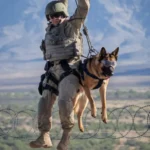Contents
In a welcome move for military families, Lufthansa has announced the reopening of select flights allowing dogs to travel alongside their owners to the United States.
This decision comes in the wake of the Centers for Disease Control and Prevention (CDC) relaxing its dog import regulations, providing much-needed relief for pet owners navigating the complexities of international travel.

Historically, many military families have relied on Lufthansa to transport their beloved pets, especially during the busy relocation season.
However, the airline, along with several others, had suspended the transport of dogs due to new CDC regulations aimed at safeguarding the U.S. from the reintroduction of rabies, which has been effectively controlled since 2007.
With the recent updates from the CDC, which take effect on August 1, 2024, there is renewed hope for families anxious about their pets’ travel arrangements.
Lufthansa’s spokesman, Joerg Waber, confirmed via email that existing bookings for dog transport will remain valid as long as all CDC requirements are met.
For new bookings starting August 1, travel will only be permitted from specific airports—Washington, D.C., New York-JFK, Atlanta, Miami, Los Angeles, and Philadelphia.
These locations have the necessary infrastructure in place, such as CDC-approved animal care facilities, to accommodate pets in case they cannot be directly admitted into the U.S.
The policy changes also maintain provisions for assistance dogs and dogs shipped separately as air freight, provided that owners comply with the CDC’s updated guidelines.
Liz Hensel, CEO of Leave No Paws Behind USA and a veteran herself, expressed cautious optimism about the developments but highlighted the need for clearer communication on Lufthansa’s website to assist families in navigating these changes.
The relaxation of CDC rules, effective through April 30, 2025, will eliminate the requirement for veterinary documents for dogs that have spent the previous six months in rabies-free or low-risk countries.
Instead, owners will only need to complete the CDC Dog Import Form online, streamlining the entry process. Additionally, dogs arriving from low-risk or rabies-free countries must be at least six months old and appear healthy upon arrival in the U.S.
As Lufthansa reopens its doors to canine travelers, military families can breathe a sigh of relief, knowing that their furry companions can once again join them on their journeys home
Conclusion:
Lufthansa’s decision to allow dogs to fly alongside their owners is a significant step forward for military families looking to reunite with their pets after lengthy deployments.
As the airline implements new measures aligned with the CDC’s relaxed regulations, it reflects a growing understanding of the emotional bonds between service members and their furry companions.
By providing clearer options and supporting families during this transition, Lufthansa is fostering a more pet-friendly travel experience.
FAQs:
- What has changed about Lufthansa’s dog transport policy?
- Lufthansa has reopened select flights for dogs to travel with their owners to the U.S. following relaxed CDC regulations regarding dog imports.
- Which airports will allow dogs to travel with their owners?
- Dogs can travel from Washington, D.C., New York-JFK, Atlanta, Miami, Los Angeles, and Philadelphia, where necessary infrastructure is in place.
- What are the new CDC requirements for importing dogs?
- Owners must complete the CDC Dog Import Form online, and dogs must appear healthy and be at least six months old at the time of entry.
- What if I already have a booking with Lufthansa for my dog?
- Existing bookings for dog transport will be honored, provided all CDC requirements are met.
- Are assistance dogs allowed to travel on Lufthansa?
- Yes, assistance dogs can still travel as long as the owners comply with the CDC’s updated regulations.
- What options are available for dogs that cannot be transported on the same flight as their owners?
- Dogs can be shipped separately as air freight, provided the new CDC guidelines are followed.







